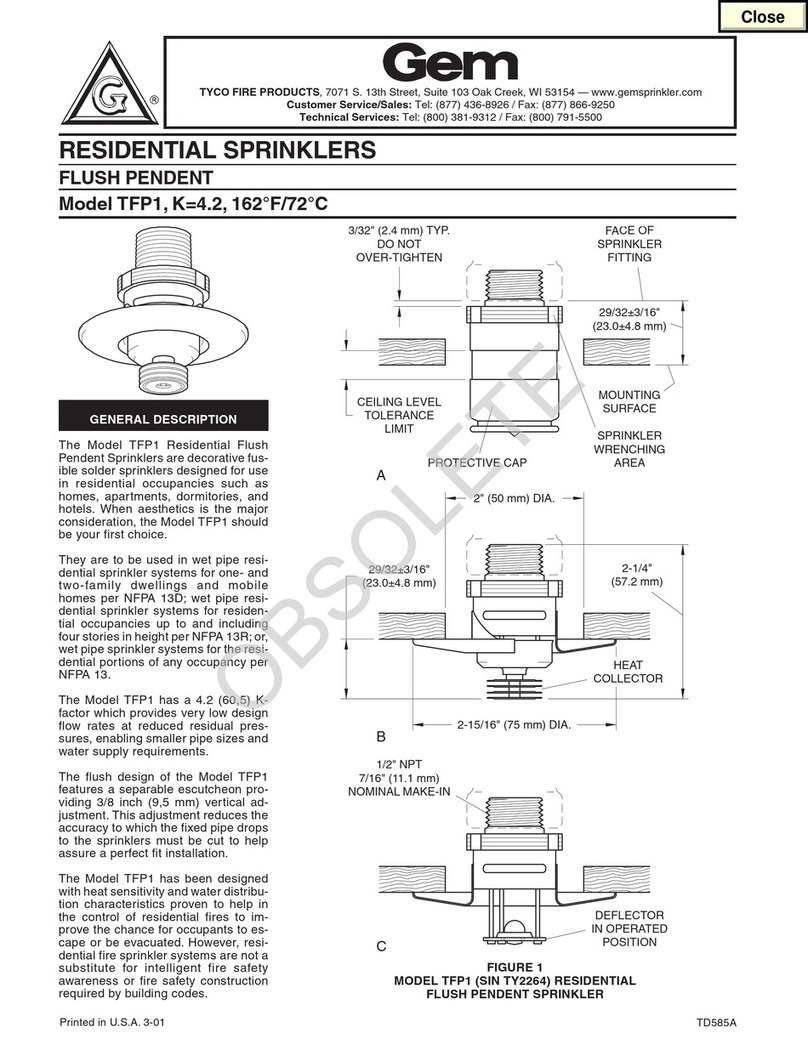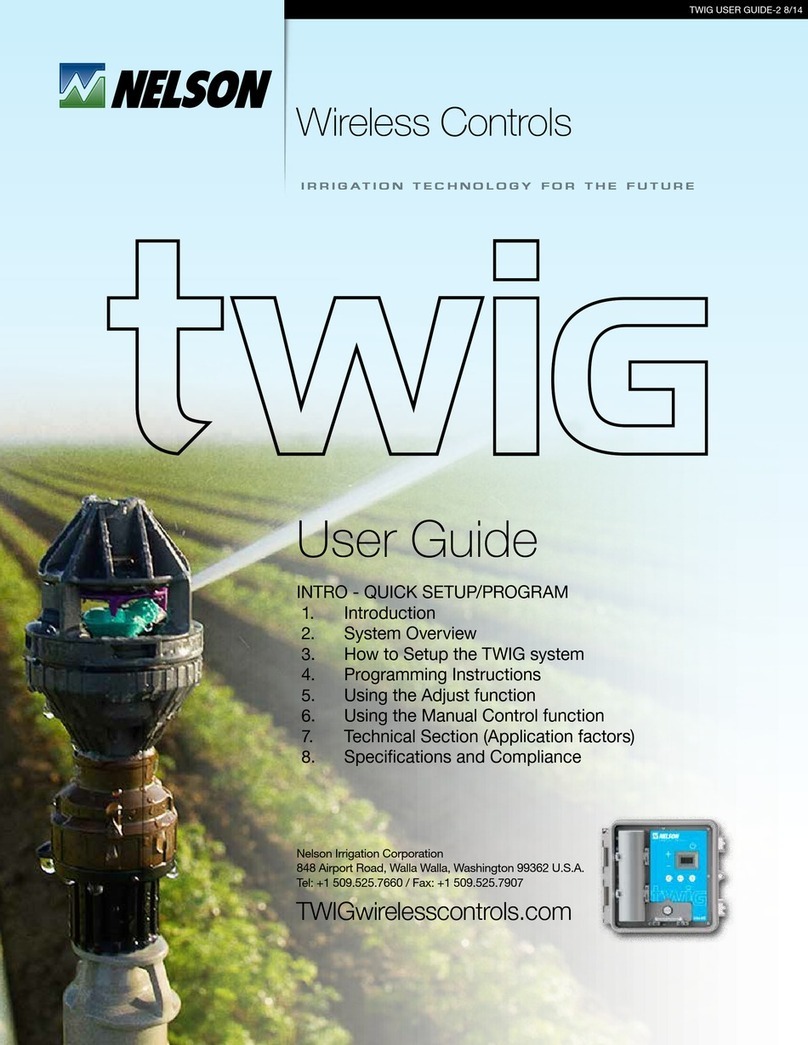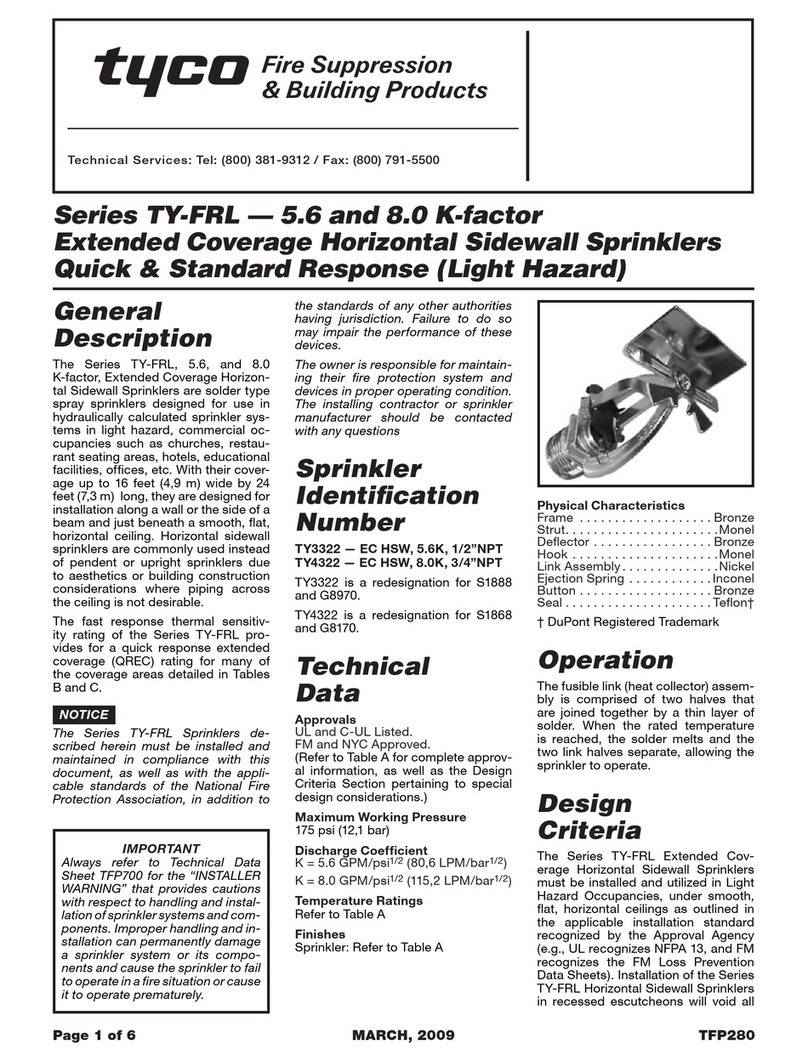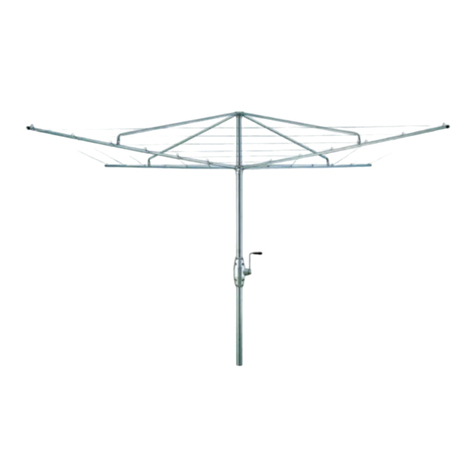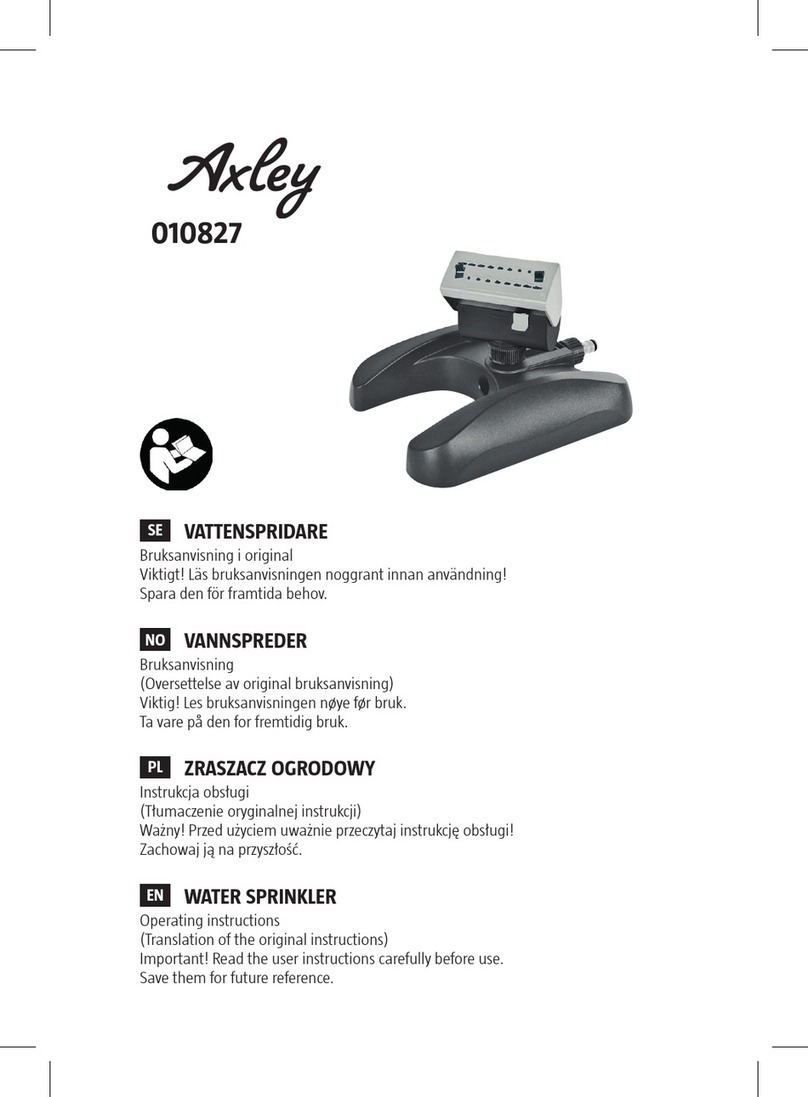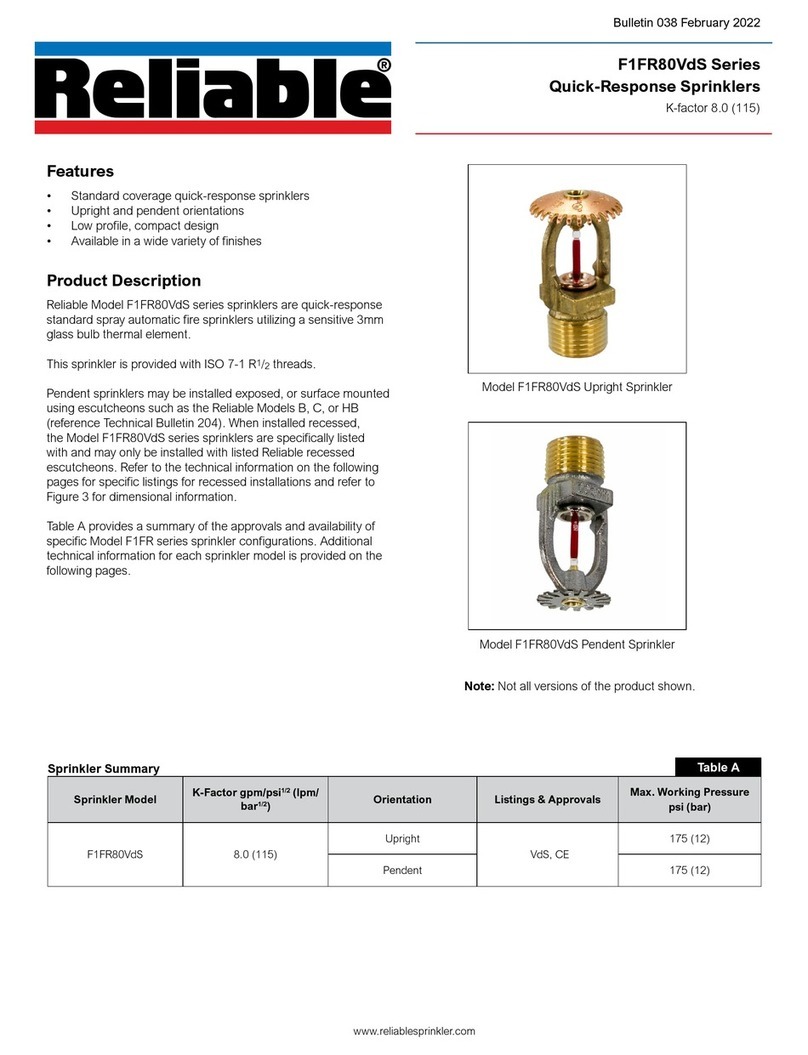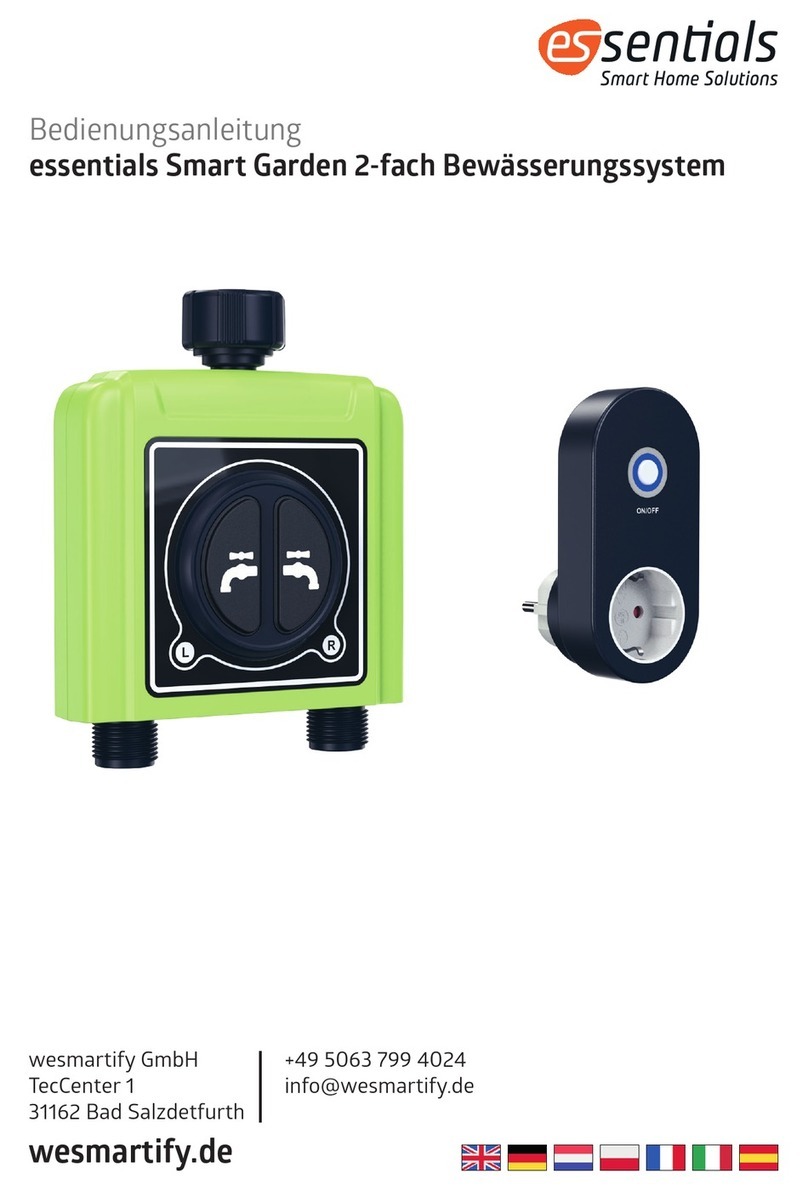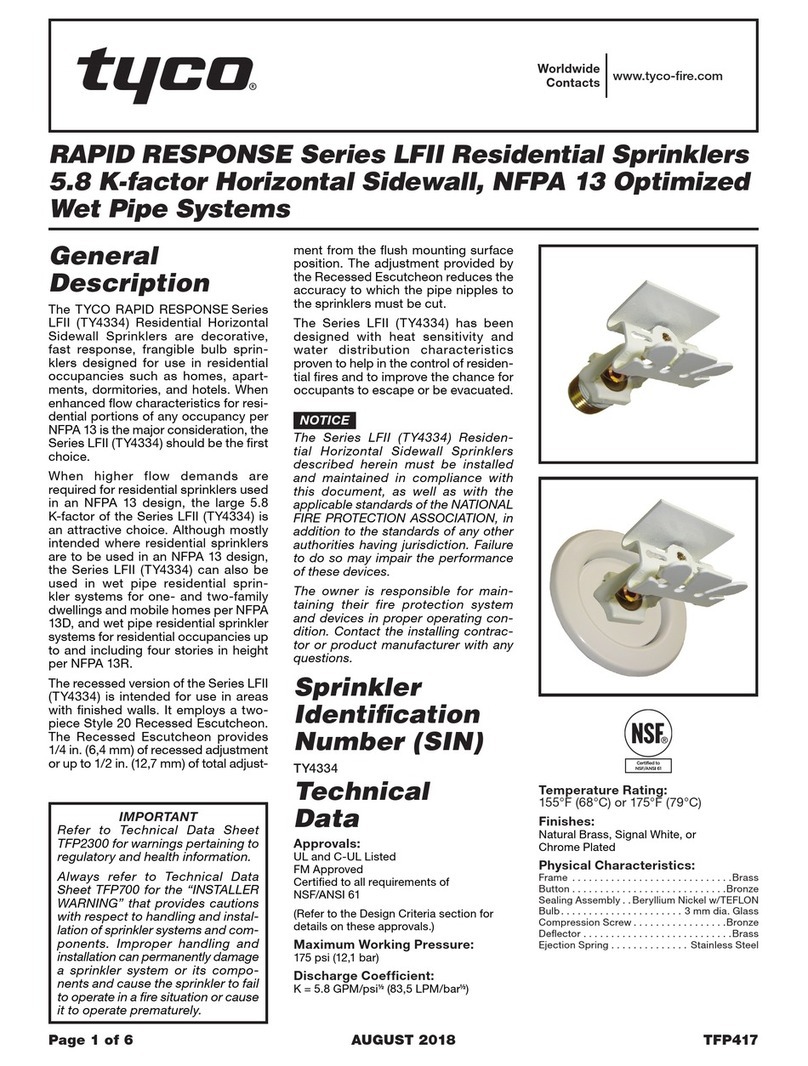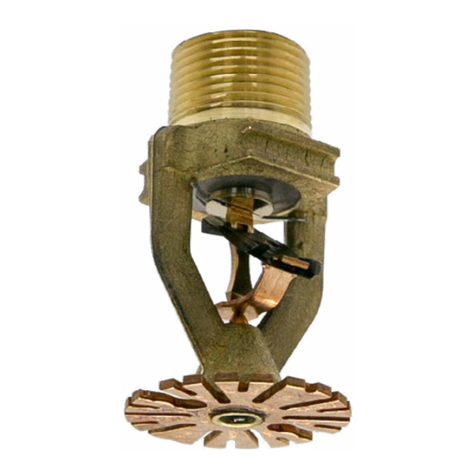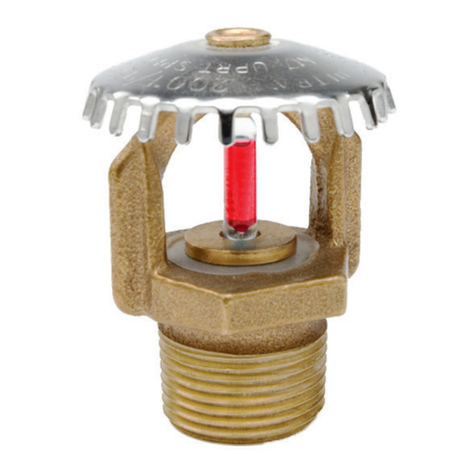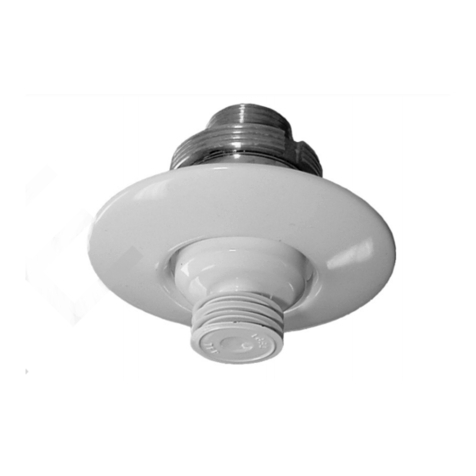NeilMed Hydro Pulse HP-100 User manual

5003S-BRO-HYDP_Rev01_Hydro Pulse_PP20170407_db
Hydro Pulse™
Nasal/Sinus Pulsatile Irrigation System And Pulsatile Throat Irrigation System
Model HP-100
By Dr. Grossan M.D.
USER INSTRUCTIONS
5003S-BRO-HYDP_Rev01_hydropulseBRO.indd 15003S-BRO-HYDP_Rev01_hydropulseBRO.indd 1 12/26/17 9:49 AM12/26/17 9:49 AM

2
Disclaimer: All products printed, shown on our websites and other materials are for universal general information. Please note that at times, a
particular country distribution and sales restrictions will apply and please contact us for any questions.
Model HP-100
Nasal/Sinus Pulsatile Irrigation
System and Pulsatile Throat
Irrigation System
TABLE OF CONTENTS
Introductions 2
Cautions 3
Warnings 5
Important Safeguards 5
Quick Reference 5
a. Nasal Irrigation
b. Throat Irrigation
Directions for Use – Nasal Irrigation 7
Nasal Irrigation Questions & Answers 9
Directions for Use – Throat Irrigation 14
Tongue Cleaning 14
Bad Breath Problems 15
Customer Service 16
INTRODUCTION
Nasal irrigation is a personal
hygiene practice used for
thousands of years in my
native India. When I moved to
the United States in 1981 to
further my medical training,
I had no idea I would find my
future in this ancient tradition.
I am a practicing physician
who specializes in pulmonary
and critical care medicine in
Santa Rosa, California. In my
practice, I have relied mostly on
the constantly evolving Western
medical technologies. However, after suffering from chronic
sinus disease and trying a range of treatments to control
my symptoms—including corrective surgery—I discovered
that the most effective therapy was the ancient practice of
nasal irrigation.
In my practice, I began prescribing this simple treatment
to my patients. I believed that routine saline nasal rinsing
would significantly reduce and may cure their symptoms.
A large number of patients did improve after trying nasal
irrigation. However, they returned with the same symptoms
when they stopped doing nasal rinses on a daily basis. I
realized the important need for a product that would be easy
to use for daily nasal rinse.
In January 2000, I formed NeilMed®Pharmaceuticals
and began marketing the SINUS RINSE™kit. This
effective and soothing large volume nasal rinse system
incorporates years of medical knowledge and the invaluable
suggestions of medical colleagues and patients. Due to the
product’s effectiveness and widespread acceptance by
doctors, NeilMed®SINUS RINSE™is now the #1
physician prescribed nasal irrigation system in the United
Contains no latex or rubber products.
Ketan C. Mehta, M.D.
CEO & Founder
5003S-BRO-HYDP_Rev01_hydropulseBRO.indd 25003S-BRO-HYDP_Rev01_hydropulseBRO.indd 2 12/26/17 9:49 AM12/26/17 9:49 AM

3
www.neilmed.com
States and Canada. It is also widely available in Australia,
New Zealand, Singapore, Malaysia, Taiwan, UK, Ireland,
Poland, Hungary, Chile and a growing number of other
European and Asian countries.
Today NeilMed®Pharmaceuticals offers a full line
of nasal irrigation and health products designed to help
children and adults breathe more freely and comfortably
through their nose. This educational brochure provides you
with directions for the proper use of our products as well as
extensive information about nasal and sinus health. Should
you have any further questions or comments, please contact
us through our website or by calling us directly. We are here
to serve you and welcome your thoughts or concerns.
Sincerely,
Ketan C. Mehta, M.D., CEO &
Founder
Diplomate, Certified by the
American Boards of Internal
NeilMed®is the #1 brand in
North America for large volume
saline nasal irrigation devices.
Our goal is to ensure the
highest possible quality, safety,
effectiveness, and ease of use
for our devices at an affordable
price.
We are highly committed
to meeting applicable regulatory, customer and quality
standards and achieving increasing levels of customer
satisfaction.
NeilMed®prides itself on quality product and values
customer satisfaction. Our policy is to provide a full money-
back guarantee within 120 days if you are unsatisfied for
any reason. Today we support medical research at several
university medical centers, and charitable causes with equal
Nina Mehta
President & Co-founder
passion. I assure you that you will be very satisfied with the
NeilMed®
brand of products and the NeilMed®
way
of customer service.
CAUTION
We recommend rinsing your nasal passages with
NeilMed®SINUS RINSE™packets or Breathe-
ease™XL mixture only. Rinsing your nasal passages
with only plain water without the saline mixture will
result in a severe burning sensation, as plain water is not
physiologic for your nasal lining, even if it is appropriate
for drinking. Additionally, for your safety, do not use tap
or faucet water for dissolving the mixture unless it has
been previously boiled for five minutes or more as boiling
sterilizes the water. Other choices are distilled, micro-
filtered (through 0.2 micron), commercially bottled or, as
mentioned earlier, previously boiled water at lukewarm
or body temperature. You can store boiled water in a
clean container for seven days or more if refrigerated.
Do not use non-chlorinated or non-ultra (0.2 micron)
filtered well water unless it is boiled and then cooled to
lukewarm or body temperature. Do not rinse if your nasal
passages are completely blocked or if you have an ear
infection or blocked ears. If you have had recent ear or
sinus surgery, contact your physician prior to irrigation. If
you experience any pressure in the ears or burning in the
nasal passages, stop irrigation and get further directions
from your physician. Keep out of reach of children. Read
and retain this enclosed brochure for instructions and
other important information.
We recommend that you use the Hydro Pulse™ONE
HOUR PRIOR to bedtime in order to avoid any residual
solution dripping down the throat.
5003S-BRO-HYDP_Rev01_hydropulseBRO.indd 35003S-BRO-HYDP_Rev01_hydropulseBRO.indd 3 12/26/17 9:49 AM12/26/17 9:49 AM

4
Patients who are unable to stand up or bend near the sink
SHOULD NOT use this product.
We strongly advise against the use of the Hydro Pulse™
on children or adults who are bed bound or have physical
limitations or mental disabilities due to developmental
or acquired disorders. Adults should read the directions
first before using it on their children. Keep out of reach of
children. Do not swallow the solution; however, if you do
so accidentally, there is no harm as the amount of sodium
ingested in one swallow is insignificant.
CAUTIONS
The Hydro Pulse is an electrical device, and like all other
electrical devices, requires precautions to guard against
fire and electric shock. Read and understand all cautions.
If you have any questions, contact customer service
before use.
READ ALL INSTRUCTIONS BEFORE USING
DANGER - To reduce the risk of electricity related
hazards:
•Always unplug this product immediately after using
•Do not use while bathing
•Do not place or store product where it can fall or be
pulled into a tub or sink
•Do not place in or drop into water or other liquids
•Do not reach for a product that has fallen into water. If
the device falls into water, unplug immediately.
•Never use this device where it could become submerged
in sink or bathtub.
•Never use this device if electric cord is frayed, if the
plug is broken, or if this device blows a fuse.
•If the device stops working, contact NeilMed®
customer service. Do not try to service or modify unit.
Never open the unit.
The NeilMed®Hydro Pulse™Pulsatile Nasal/Sinus
Irrigation System must only be used as directed. Failure
to use as directed could result in permanent personal
injury. If you have any questions about the use of this
product, contact customer service before use.
Always follow your doctor’s instructions if they are
different from those in these instructions.
Please inform your doctor that you are using this product.
Be sure to ask your doctor for instructions about use
after sinus/nasal surgery. Follow doctor’s instructions
carefully when adding prescribed antibiotic or antifungal
medications to the Hydro Pulse™.
WARNING- To reduce the risk of burns, electrocution,
fire, or injury:
•Product should never be left unattended when plugged
in. Close supervision is necessary when this product
is used by, on, or near children or invalids. The Hydro
Pulse should not be used on children under the age of 5.
•Use this product only for its intended use as described
in this manual.
•Do not use attachments not recommended by the
manufacturer
•Never operate the product if it has a damaged cord or
plug, if it is not working properly, if it has been dropped
or damaged, or dropped into water. Return the product
to a service center for examination and repair.
• Keep the cord away from heated surfaces.
• Never block the air openings of the product or place it
on a soft surface, such as a bed or couch, where the air
openings may be blocked. Keep the air openings free of
lint, hair and the like.
• Never drop or insert any object into any opening or
5003S-BRO-HYDP_Rev01_hydropulseBRO.indd 45003S-BRO-HYDP_Rev01_hydropulseBRO.indd 4 12/26/17 9:49 AM12/26/17 9:49 AM

5
www.neilmed.com
hose.
• Do not use outdoors or operate where aerosol (spray)
products are being used or where oxygen is being
administered.
• Unplug this product before filling. Fill the reservoir
with water only unless otherwise specified by the
manufacturer. Do not overfill.
• The motor in our pulsatile nasal irrigator has
temperature control. When is it overheated, the power
will shut off automatically. Wait 10 minutes to allow
motor to cool down.
• Do not use the nasal irrigator when the nose is
completely obstructed.
SAVE THESE INSTRUCTIONS
WARNING
This appliance has a polarized plug (one blade is wider
than the other). As a safety feature, this plug will fit in
a polarized outlet only one way. If the plug does not fit
fully in the outlet, reverse the plug. If it still does not fit,
contact NeilMed®customer service.
WARNING
Always remove plug with dry hands. Remove plug from
socket for storage and maintenance. Never remove cord
by pulling the wire.
If plug is dusty, clean it before inserting into the wall.
If cord or plug is damaged, contact NeilMed customer
service.
Please check the voltage label on your device and use an
electrical outlet that will give the specified output. Our
devices come with either 110 or 220 volts. Please do not
use voltage converters if you do not have the appropriate
electrical outlet available. If you are subject to electric
surges or extreme power fluctuations, use a surge
protector and unplug between uses.
This product is 100% guaranteed for one year from
date of original purchase.
IMPORTANT SAFEGUARDS
This product is not a toy and carries the same dangers
as any appliance.
Possible electric shock.
Do not take machine apart.
Remove plug from socket
QUICK REFERENCE
Nasal/Sinus Irrigation
1. Prepare solution: Fill reservoir with 16 oz (480 ml) of
warm water. Use only distilled, commercially bottled,
or previously boiled and cooled water. Filtered water
5003S-BRO-HYDP_Rev01_hydropulseBRO.indd 55003S-BRO-HYDP_Rev01_hydropulseBRO.indd 5 12/26/17 9:49 AM12/26/17 9:49 AM

6
is safe only if it has been filtered through a 0.2 micron
filter. Add NeilMed®Sinus Rinse™mixture,
Breathe-ease™XL mixture or any other saline mixture
of your choice. Make sure you do the appropriate dilution
based on the directions supplied by the manufacturer
of the mixture packets or sachets. We recommend
that you do not use homemade salt mixtures for nasal
irrigation, as they may have inaccurate concentrations
and lead to inadequate relief, a burning or stinging
sensation, or even nasal congestion. Be sure to stir
until the mixture is completely dissolved.
2. Adjust the stream so it travels to the height of two to
three inches, then use the control to start or stop the
stream.
3. Standing in front of a sink, bend forward to your
comfort level and tilt your head down.
4. Keeping your mouth open, without holding your breath,
place the tip snugly against your nostril. Turn on the
nasal irrigator. Saline will go in from one nostril, fill
up your nasal passages and drain out the other side
by gravity.
5. Use approximately one quarter to one half of the
solution per nostril. Repeat for opposite nostril.
6. Turn off the control switch.
Throat Irrigation
1. Make a solution of diluted mouth wash or saline. Plain
water can also be used.
2. Lay throat tip on the right side of the tongue so the tip
points to just behind the last tooth on the right. Adjust
to low pressure that feels comfortable. Keep length of
tip parallel to the midline of the tongue.
3. Bend down into sink at comfortable level. Use hand
control to turn on and off.
Occasionally a new machine has an air pocket and liquid
won’t come out in a smooth stream. In this case, it needs
to be primed. Fill the tank, turn on the machine, then drop
the handle as low as possible below the machine level,
making sure the handle switch is open. Once the solution
comes out in a regular stream, resume regular operation.
Very rarely, Sodium chloride, sodium bicarbonate and
residues from the dried out saline can clog the tubing if
not used on a regular basis. To prevent this, rinse with
designated quality water after each use.
5003S-BRO-HYDP_Rev01_hydropulseBRO.indd 65003S-BRO-HYDP_Rev01_hydropulseBRO.indd 6 12/26/17 9:49 AM12/26/17 9:49 AM

7
www.neilmed.com
completely dissolved.
Step 3: Attach the nasal irrigator tip
to the handle
•Slide the rim on the irrigator tip into the
grove on the handle.
Step 4: Power on button
•When using for the first time, it may
take a few seconds for water to begin
coming out.
Step 5: Adjust water pressure
•Adjust the water pressure
regulating knob before usage. Turn
it to the lowest level for the first
time. Gradually increase the water
pressure until the vertical height of
the water stream exiting the nasal
irrigator tip is two to three inches.
Step 6: Start Irrigating
• Let water stream out of the tip for a few seconds before
you begin irrigating to flush out any residual water left
in the machine.
• Lean over the sink. Bend your head (like taking a bow),
so you are directly facing the sink’s drainage hole.
• Keeping your mouth open, without
holding your breath, place the
tip snugly against your nostril.
Turn on the nasal irrigator. Saline
will go in from one nostril and
drain out the other side. DO NOT
swallow or spit when irrigating.
Use the temporary stop knob on
STRONG (High)
WEAK (Low)
OFF ON
DIRECTIONS
Step 1: Plug the machine into
the power source of designated
voltage
Step 2: Placing the water
reservoir
•Remove the water reservoir
and open the lid to fill it with
16 oz, or 480 mL, of warm
distilled, commercially bottled,
or previously boiled and cooled
water. Filtered water may
be used only if it has been
filtered through a 0.2 micron
filter. Put the water reservoir
back to its original position. Use
lukewarm water, in the range of
92°F~101°F(33°C~38°C).
•Add NeilMed®Sinus
Rinse™mixture or Breathe-
ease™XL mixture. Make sure
you do the appropriate dilution
based on the directions supplied by the manufacturer.
We recommend that you do not use homemade
salt mixtures for nasal irrigation, as they may have
inaccurate concentrations and lead to inadequate
relief, a burning or stinging sensation, or even
nasal congestion. Be sure to stir until the mixture is
• To turn ON,
push button
upward
• To turn OFF,
push button
downward
5003S-BRO-HYDP_Rev01_hydropulseBRO.indd 75003S-BRO-HYDP_Rev01_hydropulseBRO.indd 7 12/26/17 9:49 AM12/26/17 9:49 AM

8
the handle to temporarily discontinue the irrigation if
you wish to spit. (To turn the flow on, push the knob
upward, and to turn it off, push the knob downward.)
Or, you can just remove the nasal tip from your nostril.
• Use 125 to 250 mL, or 4 to 8 ounces, of solution for
each nostril.
• Blow your nose very gently, ensuring not to pinch
completely to avoid pressure on your eardrums. If
tolerable, sniff in any residual solution remaining in the
nasal passage once or twice. This may clean out the
posterior nasopharyngeal area, which is the area at the
back of your nasal passage. Generally, the fluid in your
sinuses will exit about 20 minutes later when the cilia
are activated.
Step 7: Instructions for Cleaning and Disinfecting
Device:
• Refill the basin with distilled or bottled or previously
boiled and cooled water and run the machine to flush
out any residual solution. To drain water, drop the level
of the handle in an open position below the machine
level to siphon out the solution.
•Turn basin upside down with top open to allow for the
air. When dry, replace the basin on the machine. Be
sure lid is kept closed. Do not leave water in the basin.
• After each use, clean the tip with warm water and
dishwashing detergent. Be sure to rinse thoroughly and
dry completely.
For regular use, follow one of the below disinfecting
protocols every 1 to 2 weeks:
Household Bleach Disinfection Protocol: Add 60 mL
(about 2 oz) of bleach and fill the basin with water. Run
the machine for about 120 mL (4 oz) back into the basin.
Place nasal and throat attachments you have used into
the basin. Carefully time 10 minutes and run the solution
out through the machine. Rinse the basin thoroughly. Fill
with fresh water and run three to four full cycles, or until
the solution no longer has the bleach smell. Never use
bleach full strength as this will damage the washer rings
(O rings). Soaking longer than 10 minutes will damage
the rubber or silicone parts.
Vinegar Disinfection Protocol: Fill the basin with 1 part
white vinegar and 3 parts hot water. Submerge the tips
that you have used in the basin and soak for 30 minutes.
Remove the tips and rinse under running water. Run
the dilute vinegar solution out through the machine. Fill
with fresh water and run three to four full cycles, or until
the solution no longer has a vinegar smell. Dry all parts
completely.
Hydrogen Peroxide cleaning protocol: Fill the basin
with 1 part hydrogen peroxide and 3 parts hot water.
Submerge the tips that you have used in the basin and
soak for 30 minutes. Remove the tips and rinse under
running water. Run the dilute hydrogen peroxide solution
out through the machine. Fill with fresh water and run
three to four full cycles. Dry all parts completely.
After 10 minutes of continuous use, rest the machine for
several minutes to allow the motor to cool.
BE GENTLE in blowing your nose. Generally the fluid in
your sinuses will exit about 20 minutes after when the
cilia are activated.
NeilMed®Hydro Pulse™may help natural healing
by:
1. Restoring ciliary movement: Cilia are pulsed by speed
5003S-BRO-HYDP_Rev01_hydropulseBRO.indd 85003S-BRO-HYDP_Rev01_hydropulseBRO.indd 8 12/26/17 9:50 AM12/26/17 9:50 AM

9
www.neilmed.com
Some physicians do recommend Hypertonic (double
or triple the saline concentration) solutions in certain
cases. They believe that a higher concentration will draw
the fluid and excessive mucus out of congested nasal
and sinus openings. If you prefer higher salinity or a
Hypertonic solution, you can use 2 or 3 times the saline
mixture directed above. For example, one may use 2
green NeilMed®Sinus Rinse™Premixed Packets,
or 2 scoops of the Breathe-ease™XL mixture. As
always, be sure to stir until the mixture is fully dissolved.
Q4. Why do you need such a large volume of
solution?
A large volume of saline solutions creates a momentum
that sweeps away allergens, excess mucus, pollutants,
dust and animal dander in the path of the flow.
Q5. Why do you recommend low pressure and not
high?
Low pressure will ensure that no discomfort is
experienced in the ears or sinuses.
Q6. Q6. What temperature should the water be?
Most persons prefer lukewarm or body temperature.
NEVER use HOT water – above 100.5° F.
Q7. What about cold water?
Cold water tends to shrink the membranes and can be
used, although many users will find this uncomfortable.
Q8. What is the best time of day to do a nasal rinse?
Nasal rinses can be done at any time of day, however,
we recommend that you rinse at least one hour before
leaving your home or going to bed. This is to avoid
the occasional drainage of a small amount of leftover
solution or liquefied mucus from the nasal passages,
and thick mucus may be removed to allow cilia to
move.
2. Physically displacing excess mucus: Excessive
mucus may be displaced from the sinus cavities by
the combination of flow past the opening (Bernoulli’s
effect) and pulsating pumping action.
3. Removing Biofilm: Biofilm that encircles bacteria as
well as actual bacteria may be removed or disrupted.
QUESTIONS AND ANSWERS
Q1. What is the advantage of nasal rinsing?
Some amount of mucus production from the nasal
and sinus lining is normal. Allergies and infections will
cause excessive mucus production. This creates nasal
and sinus symptoms such as runny and stuffy nose and
post-nasal drip. When you perform a nasal rinse, you
wash away excess mucus and irritants such as pollen,
dust particles, pollutants and bacteria, thus reducing
inflammation of the mucus membrane. Normal mucosa
will fight infections and allergies better, and symptoms
may be reduced.
Q2. How much saline mixture should I use for nasal
irrigation with the Hydro Pulse™?
Always follow the directions from the manufacturer for
the mixture you are using. To make a 480 mL nasal
wash, we suggest using 1 green NeilMed®Sinus
Rinse™Premixed Packet or 2 blue NeilMed®Sinus
Rinse™Premixed Packets to make an isotonic solution.
One can also use 1 Breathe-ease™XL Premixed Packet
or 1 scoop of Breathe-ease™XL mixture.
Q3. What if I prefer a higher concentration of salt
solution?
5003S-BRO-HYDP_Rev01_hydropulseBRO.indd 95003S-BRO-HYDP_Rev01_hydropulseBRO.indd 9 12/26/17 9:50 AM12/26/17 9:50 AM

10
which may drip down the throat or out of the nose shortly
after irrigation.
Q9. How many times a day can a nasal rinse be
performed?
Most users find that rinsing twice a day is most beneficial.
In our opinion, rinsing 3-4 times per day or for special
circumstances, even rinsing up to 6 times per day, is
safe. Please follow your physician’s advice.
Q10. What are the causes of a burning sensation
related to nasal irrigation?
Under normal circumstances, you should not feel any
burning or stinging if you have created the proper dilution
with NeilMed Sinus Rinse or BreatheEase XL mixtures.
Causes of a burning sensation include:
1. Forgetting to put the saline mixture in the tank
2. Using more than the specified quantity of mixture for
the water quantity
3. Using water that is too hot or too cold
4. Not thoroughly dissolving the mixture in the water
If you are following all directions and still experiencing
burning or stinging, please discontinue nasal rinsing and
contact our customer service department for advice.
Q11. What should I do if the nasal rinse causes pain
in the ear?
Nasal rinsing is not recommended if you have an acute
or new ear infection or ear discomfort of any kind. We
advise that you consult your physician before starting
rinses, or wait until symptoms subside. If symptoms
recur, stop the rinses and consult your physician as soon
as possible.
Q12. What is my nasal passage feels stuffy after
using the rinse?
Some people experience reflex or rebound congestion
with exposure to saline. This condition is usually very
transient. If symptoms continue, consider using a
Hypertonic (double strength) solution, or use an over-the-
counter decongestant for a day or two. This is usually
a very benign and mild condition that should resolve
with time. Unless very symptomatic, there is no need to
discontinue ongoing irrigation. It will most likely resolve
on its own.
Q13. Can I add any other ingredients, such as
eucalyptus oil, alcohol, herbal medications,
corticosteroids, or antibiotics?
Please check with your physician, as there are various
options available. We will not give any recommendations.
Q14. What should I do if I happen to swallow the
saline during the nasal irrigation procedure?
It should not cause any harm, even if you have high blood
pressure or a heart condition. If you follow our directions,
tilting your head forward, the chances of solution
reaching the back of the throat are very small.
Q15. Is it common for solution to drain from my nose
after rinsing?
Yes, this is very common, and is why we do not
recommend rinsing your nasal passages right before
going to bed. This will generally happen in the 15 to 20
minutes after using the rinse.
Q16. Should workers exposed to occupational dust
perform nasal rinses?
Workers who are exposed to large amounts of
5003S-BRO-HYDP_Rev01_hydropulseBRO.indd 105003S-BRO-HYDP_Rev01_hydropulseBRO.indd 10 12/26/17 9:50 AM12/26/17 9:50 AM

11
www.neilmed.com
environmental or occupational dust from construction
work, farming, mining and various other occupations may
benefit from regular use of the nasal rinse procedure. You
should rinse the nose as soon as possible after exposure.
The sooner the irritant is removed from the delicate
membranes, the less likely it is that the membranes will
become inflamed and congested.
Q17. Do nasal rinses improve the sense of smell?
We know that chronic rhinitis and sinus symptoms will
adversely affect the sense of smell and taste. Nasal
rinses will symptomatically improve many nasal and
sinus conditions. There are no medical publications at
this time to show any correlation between rinses and
sense of smell.
Q18. What is rhinitis?
Rhinitis is an inflammation of the mucosa (the delicate
lining of the inner body surfaces) of nasal passages.
Q19. What is sinusitis?
Sinusitis is an inflammation of the mucosa of various
sinuses.
Q20. How does one differentiate between rhinitis
and sinusitis?
Due to overlapping symptoms, it may be difficult to
differentiate between the two. Usually, symptoms of
rhinitis include stuffy, runny, or drippy nose, scratchy
throat and dry cough. Symptoms of sinusitis are more
severe than the symptoms of rhinitis and often include
increased nasal secretions and pain around the sinuses,
such as facial pressure and pain.
Q21. What are the symptoms related to sinusitis and
blockage of the ostia (openings of the sinuses)?
The following are symptoms of acute & chronic sinusitis:
•Nighttime cough due to post nasal drip
•Pain in the upper jaw or teeth
•Loss of sense of smell or taste
•White, yellow or green discharge
•Nasal Congestion
•Runny nose
•Headache
•Persistent Fatigue
•Facial Pressure
•Snoring
•Ear Pain
•Fever
Q22. What are the causes of rhinitis and sinusitis?
•Cold viruses
•Allergies, including food allergies
•Bacterial or fungal infections
•Grass
•Dust, smog, or environmental pollutants
•Nasal polyps and deviated nasal septum
•Moderate to severe gastroesophageal acid reflux disease
(GERD)
•Smoking
Q23. Can nasal rinses prevent or reduce a head cold
or flu symptoms?
In the initial stages of a head cold and/or flu, saline rinses
in large volume help reduce excess mucus and keep
5003S-BRO-HYDP_Rev01_hydropulseBRO.indd 115003S-BRO-HYDP_Rev01_hydropulseBRO.indd 11 12/26/17 9:50 AM12/26/17 9:50 AM

12
frequent rinsing. Consult with your physician about safe
and effective post-operation nasal irrigation.
Q27. What is a corticosteroid nasal spray?
Synthetic or pharmaceutical corticosteroids are anti-
inflammatory drugs. They are not anabolic steroids
so please do not confuse these two. Physicians
prescribe corticosteroid nasal sprays to reduce chronic
inflammation of the mucosa (mucus membrane) of nasal
passages and sinuses.
Q28. What are nasal decongestants and when do I
use them?
Nasal decongestants constrict the dilated blood vessels
and reduce nasal and sinus congestion. You can ask
further advice about when to use them from your doctor
or pharmacist.
Q29. What are antihistamines?
Antihistamines are the most common medications used
to treat allergies. They work by blocking the effects of
histamine, which is released during an allergic reaction.
They help relieve the symptoms of sneezing, itchy nose
and eyes and runny nose. They are not as helpful with
nasal congestion.
Q30. Can I drink alcohol during acute or chronic
symptoms of rhinitis and sinusitis?
Some individuals may get skin flushing and nasal
congestion with the use of alcohol. Alcohol worsens
these symptoms and it is recommended that you check
first with your doctor or do not use alcohol while these
symptoms persist.
Q31. Does smoking lead to rhinitis and sinusitis?
Yes, smoking can lead to rhinitis and sinusitis due to
sinus passages clear.
Q24. How do I know if I need surgery for my sinuses?
There are various forms of endoscopic sinus surgeries
(ESS or FESS) that can often cure or improve symptoms.
We strongly advise that you contact your physician. You
can request your doctor to refer you to an ENT (ear, nose
& throat) or allergy specialist if your symptoms are not
improving.
Q25. What is FESS & ESS?
Functional Endoscopic Sinus Surgery (FESS) is a
commonly used term for endoscopic sinus surgery
(ESS) and generally involves very little post-operative
discomfort. Current technology including fiber optics,
video cameras, high resolution video monitors and
high resolution advanced CAT scanners allow excellent
examination of all openings of the sinuses, nasal
turbinates and nasal septum. When required, surgery will
restore the anatomy to as normal as possible or more
likely as functional as possible by removing obstructions
and improving drainage. FESS or ESS can help improve
or, in many, cases cure the symptoms of chronic sinusitis.
Q26. Would I need to change my nasal irrigation
technique after sinus surgery?
You may need to rinse more carefully, and you may find
that a larger amount of rinse solution will be necessary.
For best results, after you finish rinsing, you may need
to take a little more time to change head positions to
allow more complete drainage from the sinuses. While
bending over the sink, tilt your head sideways to help
improve the drainage of any residual rinse solution. A lot
of the post sinus surgery population may require more
5003S-BRO-HYDP_Rev01_hydropulseBRO.indd 125003S-BRO-HYDP_Rev01_hydropulseBRO.indd 12 12/26/17 9:50 AM12/26/17 9:50 AM

13
www.neilmed.com
constant irritation.
Q32. Does rhinitis or sinusitis affect asthma?
It has been established that there is a definite correlation
between the symptoms of rhinitis, chronic sinusitis and
asthma. This is based on the unified or united airway
disease, as all the areas are contiguous. Curing or
reducing rhinitis or sinusitis may improve the symptoms
of asthma significantly. Approximately 80% of the
patients suffering from allergic asthma have coexisting
allergic rhinitis.
Q33. What are allergens or allergy inducing particles?
Allergens are usually organic particles that attach to
the nasal mucosa or respiratory mucosa and lead to
the development of an antibody, which creates a series
of chemical reactions leading to allergic symptoms.
Everybody’s reaction to allergen exposure is different.
The same amount of exposure to allergy particles can
cause mild, moderate, or severe reactions in different
people. Some may not have any reactions at all. Those
with moderate to severe reactions will have symptoms.
Q34. Can you name a few allergens?
There are indoor allergens as well as outdoor allergens.
Examples of indoor allergens include dust mites, molds,
pet dander (from animals and birds) and pests. Examples
of outdoor allergens are pollen, grass, wood dust, and
mold. Other substances such as cigarette smoke,
perfumes and aerosol spray can be irritants and worsen
allergy and sinus symptoms, or can act as allergens
themselves.
Q35. Are allergens always visible?
Most individual allergens are not visible. Dust mites
are a typical example. They are not visible to the naked
eye, yet they are present in every house. Dust mites are
microscopic creatures that feed on human skin flakes
and are present in mattresses, pillows, carpets and
upholstery.
Q36. How do I reduce the problem of dust mites?
Clean all the areas where dust may be collecting. Carpets
and sofa upholstery should be vacuumed on a regular
basis. Wash pillow cases, sheets and blankets in hot
water. Enclose mattresses and pillows in special allergy
proof encasements. You can also contact an allergy care
or supply company for more details.
Q37. What is mold?
Mold is a fungus. It can be present in any area where it
is damp and warm, especially in basements, bathrooms,
kitchens and water damaged areas, such as wood,
carpets, water coolers and heater fans.
Q38. What is pet dander?
Any pet with hair or feathers will shed dander. These tiny
particles come from its skin. Dander is a very common
cause of indoor allergies in the home and in other areas
where animals and birds are raised.
Q39. What is seasonal allergic rhinitis?
Allergy symptoms that bother you only at certain times of
the year, such as spring or autumn, are commonly called
hay fever, or seasonal allergic rhinitis. These symptoms
are commonly caused by pollens and occasionally molds.
Q40. What is perennial allergic rhinitis?
This occurs when a person develops symptoms
throughout the year whenever he or she is exposed to
5003S-BRO-HYDP_Rev01_hydropulseBRO.indd 135003S-BRO-HYDP_Rev01_hydropulseBRO.indd 13 12/26/17 9:50 AM12/26/17 9:50 AM

14
specific allergens, such as dust or cat dander.
We hope you have gained useful information from
this literature. We are confident that NeilMed®
brand products will help you breathe more freely and
comfortably. In our efforts to improve our products, we
appreciate any feedback you may have. Write to us at
Thank you.
USE OF THROAT IRRIGATOR
Throat Irrigator Directions:
1. Attach Grossan Original Throat Irrigator Tip®by
pushing the rim into the groove of the handle until it
clicks in place.
2. Fill basin of irrigator with warm water. You can irrigate
with plain water or add one teaspoon of salt or one
capful of mouth wash.
3. Always set irrigator at lowest setting. Turn on and off
at the handle.
4. Set the throat tip so that the length is parallel to the
tongue, to the right of the midline. Aim for just behind
the last lower tooth.
5. Lean over the sink. Turn on irrigator. Make sure it is
set on low. A gentle water stream will massage the
throat, tonsils and tongue, depending on how you
have positioned the tip. Some persons may experience
gagging if the stream enters too far back in the throat.
Gently pull the scraper back and forth on the tongue to
remove odor causing particulate matter.
6. Turn off the unit and rinse the throat tip thoroughly
with clean water.
For fresh daily breath, use once in the morning.
For onset of sore throat, use 4 times a day.
For severe infected throat, follow your doctor’s
direction.
How It Works:
The Grossan Original Throat Irrigator Tip®sends
a gentle, pulsating stream of solution over the throat.
Unlike gargles and mouthwashes, the original throat
irrigator may penetrate pores and crevices to gently
rinse away food particles and odor causing bacteria for
cleaner, fresher breath. The pulsatile action may get into
the deep crevices of the tonsils.
TONGUE CLEANING
Food particles and debris may lay stagnant on the tongue.
Use the tongue scraper by gently moving from back to
front, either without the stream or with the stream set to
low. If there is any bleeding, stop and see your doctor. Do
not use to treat a lesion or growth of the tongue. In this
case, seek medical advice.
For Good Throat Hygiene, Remember the Following
Rules:
5003S-BRO-HYDP_Rev01_hydropulseBRO.indd 145003S-BRO-HYDP_Rev01_hydropulseBRO.indd 14 12/26/17 9:50 AM12/26/17 9:50 AM

15
www.neilmed.com
in the back of the throat, and more importantly, to make
sure you neutralize odor caused by this excess mucus.
Q1. I was told that if I use the throat irrigator I could
avoid tonsil surgery. Is this true?
If the tonsils are diseased, washing them out in this
manner and improving drainage may potentially help
restore the tonsils to health. Consult your doctor.
Q2. What is the best solution to use for throat
irrigation?
Consult your health professional on this. Most persons
prefer to use over the counter mouth wash solutions that
have been diluted with water. Saline or plain water are
fine as well. It is the stream pulsation that really helps.
Q3. How often should I irrigate the throat?
For general breath control, irrigate once a day. To prevent
a sore throat or at the early onset of a throat problem,
irrigate 4 to 6 times a day, or as needed.
Q4. Can I use the same solution for my throat after I
finish the nasal irrigation?
Yes, you can use the nasal solution for the throat, but
you cannot use any ordinary throat solution for the nasal
irrigation.
Q5. I have used the nasal irrigation, throat irrigation
and tongue cleaner, but I am told I still have a breath
problem. What are other possibilities?
Pulsatile nasal and throat irrigation and tongue cleaning
takes care of a lot of causes of breath problems. You still
must floss daily. Other causes include gum or periodontal
disease, dental disease, acid reflux and lung infection.
Speak to your health professional.
1. Never clear your throat with excessive force.
2. Do not use sore throat medications more often than
directed.
3. Excessive dryness of the air is not good for your throat.
A simple bowl of water in the bedroom at night may
help prevent this.
4. Avoid gargling. This can cause hoarseness and strain
the voice.
BAD BREATH PROBLEMS
Breath problems can affect your health and social
relations. Most breath problems come from breakdown
of proteins by certain bacteria from the nose, mouth, and
throat. There are a small number that can come from a
serious chest condition, but these are usually noted at
once because the patient is sick. Most breath conditions
can occur in otherwise healthy persons. The Hydro
Pulse™is designed to aid most breath problems.
Anything that dries the mouth can lead to odor because
the natural flora of the mouth is no longer washed away,
so the bacteria can multiply and give off odor. Fasting,
dieting, drying medications, and dry mouth on awakening
are common causes. Certain conditions that decrease
saliva flow cause “stasis” of the salivary liquid and
dryness of the mouth.
Sinus and throat irrigation with the Hydro Pulse™Nasal/
Sinus Irrigation System is an effective method to help
control bad odors resulting from excessive mucus, post-
nasal drip, tonsil stones, and sinus infections. The Hydro
Pulse™helps to minimize the amount of excess mucus
5003S-BRO-HYDP_Rev01_hydropulseBRO.indd 155003S-BRO-HYDP_Rev01_hydropulseBRO.indd 15 12/26/17 9:50 AM12/26/17 9:50 AM

ORDERING INFORMATION
If any components of NeilMed®products are missing or damaged, please do not return the item to the place
1-707-525-3784 or your nearest NeilMed office. We will send you the replacements for FREE.
MISSING OR DAMAGED PARTS
CANADA
1300 Rodick Rd., Unit A
Markham, ON L3R8C3
Toll Free: 1(877) 477-8633
T: +1(905) 480-0202
F: +1(905) 480-0201
JAPAN
NeilMed Pharmaceuticals K.K.
4-7-11, Tokai, Ohta-ku,
Tokyo, Japan 143-0001
T: +81 (03) 5755 9876
F: +81 (03) 5539 4493
www.neilmed.jp
SINGAPORE
66 Tannery Lane
#01-02D Sindo Industrial
Building, Singapore 347805
T: +65 (0)6 221 8948
F: +65 (0)6 491 5930
USA - HEAD OFFICE/MFG
601 Aviation Blvd.,
Santa Rosa, CA 95403
Toll Free: 1(877) 477-8633
T: +1(707) 525-3784
F: +1(707) 525-3785
www.neilmed.com
UK/EUROPE/IRE
PO Box #2853 Coulsdon, Surrey,
CR5 2WN, UK
T: +44 (0)208 660 9447
F: +44 (0)207 900 6414
IRE-IRL/EU Tel: +353 (0) 16569710
www.neilmed.co.uk
AUSTRALIA
12/354 Chisholm Rd.,
Auburn, NSW 2144
Toll Free: 1800 158 900
T: +61 1300 652 148
F: +61 (03) 8677 9989
www.neilmed.com.au
NEW ZEALAND
PO Box #27310
Mount Roskill
Auckland 1440
Toll Free: 0800 634 5633
T: +64 (0)9 570 7279
F: +64 (0)9 353 1430
INDIA
Suite 1 C, #118
Neil Rao Towers, Road #3
EPIP Zone, Whitefield
Bangalore 560066
T: +91 80 4161 3512
F: +91 80 4160 5707
16
5003S-BRO-HYDP_Rev01_hydropulseBRO.indd 165003S-BRO-HYDP_Rev01_hydropulseBRO.indd 16 12/26/17 9:50 AM12/26/17 9:50 AM
Table of contents
Other NeilMed Irrigation System manuals


